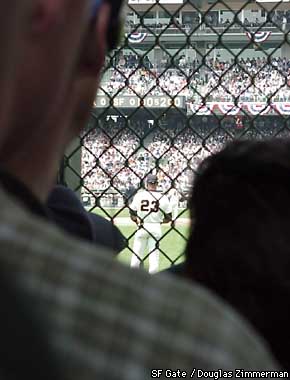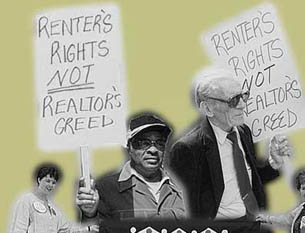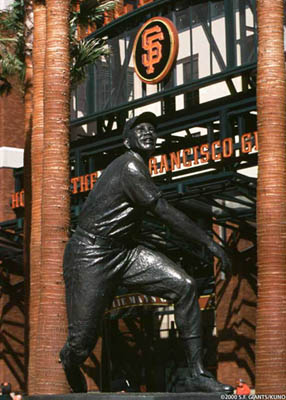Synthesis |
San
Francisco has maintained its economic wealth and prominence among cities
because of its resources like Pac Bell Park that make it a desirable location
for future investments. Indeed the efforts of the growth machine formed
by the local politicians and Giants' owners at the time created a ballpark
that added to the prestige and desirability of San Francisco. Pac Bell
Park has made attending a baseball game enjoyable, reasonably affordable,
and easily accessible. The multiple forms of public transportation connect
the entire Bay Area to this destination. People can pay for a ticket and
from inside the stadium or take a free peak from the viewing area at McCovey
Cove. Unfortunately, the accessibility to the stadium is in stark contrast
to the decreased accessibility to housing in San Francisco. |
 |
San
Francisco's housing market is renown for high demand met by unaffordable
housing costs. Adriel Hampton of the San Francisco Examiner reported in
April 12, 2002 that the housing crunch in San Francisco was worsening
and pushing out the middle classes. Property values in the city were increasing,
raising rents and evicting the lower class from their neighborhoods as
well. The city was continuing to develop expensive apartments that were
only affordable to the wealthy, as exemplified by the Embarcadero One.
The Embarcadero One is an elite apartment complex located across from
Pac Bell Park. According to San Francisco Business News, it contains more
than 233 units that rented for $750,000 when first introduced in 2000.
Although the downturn in the economy caused prices to be lowered,, they
still cost upwards of $500,000. The Embarcadero One developers and other
developers are moving into the area because they are attracted by the
easy transportation and shops that have developed as a result of the ballpark.
However, the expensive housing they develop fosters the gentrification
of the area and the continued gentrification of San Francisco, resulting
in a strong demand for affordable housing with no supply. The union that
develops between exchange values sought by landlords and the aesthetic
use value craved by rich gentrifiers alienates those who do not have the
capital to participate. |
 |
Pac Bell Park serves as a site
to give a sense of community back to San Francisco when that sense of
community is threatened by the social conflicts that develop within the
city from issues like gentrification. With urbanization comes a variety
of individuals with differing opinions. In order to promote a sense of
community among these citizens, cities need to create spaces where citizens
will feel united with others. Now, imagine 40, 000 people all converging
to Pac Bell Park, flooding the sidewalks with continuous steams of fans
unloading out of vehicles and public transportation to see a baseball
game. Regardless of whether these people know one another, they are all
headed to Pac Bell Park to enjoy a baseball game. They become a group
of people unified through a commonality in purpose. |
 |
The
ballpark itself sells a nostalgia for the way San Francisco baseball might
have been through the stadiums brick facade, mix of Giants' baseball memorabilia,
and seats that are intimately close to the field. The ballpark is filled
with various gourmet restaurants serving everything from hot dogs and
hamburgers to sushi, clam chowder from Boudin Bakery and garlic fries
from Gordon Biersch Brewery. The diversity of foods reflects the culinary
excellence and diversity expected of San Francisco. The park faces the
San Francisco Bay with views of Oakland and the Bay Bridge. The architecture
and feeling within the park creates an illusion of being in a microcosm
of San Francisco itself. However, instead of experiencing the social conflicts
that occur because of issues in the city, like gentrification, everyone
who comes to the park feels a sense of community within its confines.
Community is created in a space that mimics the city because the imitation
is safe from the conflicts of the real city. Therefore a feeling of a
San Franciscan community is created within this theme space. When one
leaves the stadium to cross the street and sees the Embarcadero One, the
reality of a less unified San Francisco is apparent and the illusion provided
by the ballpark is gone. |
The
accessibility to the park by well planned public transportation and streets
serves to maintain the illusion. Community, as defined by urban theorist,
Harvey Zorbaugh, had to be a local area with a network of institutions
that gave morals and values to its inhabitants and resulted in the ultimate
unconscious feeling of belonging that should exist in a community. He
states that "a community is a local area over which people are…conforming
to the same mores…and acting upon the same attitudes" (Zorbaugh
223). The network of institutions is supposed to provide the framework
of values for the community. However, transportation allows people to
look beyond their immediate surroundings for a feeling of community. The
physical movement and convergence to this site provides the illusion of
community gathering. Instead of creating networks within the institutions
surrounding their residences, transportation allows people to choose where
they want to feel community. People can physically transport themselves
to spaces where they feel a sense of security. Therefore people choose
to go to Pac Bell Park because the theme space provides an atmosphere
that succeeds in gives a feeling of a city community. As cities compete with one another for investments, the city that can provide security and community to its inhabitants will attract capital investments. Ultimately, individuals make decisions about where they choose to invest their capital. So, cities must make themselves attractive to the individual. San Francisco has succeeded in making itself a distinct, prominent city among cities by providing amenities like the ballpark that promote a sense of community. The city assures the promise of community through providing spaces like the ballpark to give a sense of unity to the city. It is this promise that will continue its prosperity.
Source: Harvey Zorbaugh. The Gold Coast and the Slum. Chicago: University of Chicago Press, 1929. |